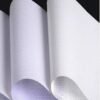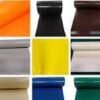In the world of marketing, construction, and outdoor events, the demand for materials that are durable, visually captivating, and versatile has never been greater. Among the materials that have risen in popularity, 3D tarpaulins have carved out a significant niche. These innovative tarpaulins offer an eye-catching, realistic look that adds depth and dimension to traditional advertising and protective covers. But how do these tarpaulins work, and what is the technology behind their creation? In this blog, we will dive into the technology behind these materials and their manufacturing process to understand what makes them stand out.
What Are 3D Tarpaulins?
A 3D tarpaulin is essentially a visual product made from traditional tarpaulin material but designed to appear three-dimensional. The key element that distinguishes them from standard tarpaulins is the use of advanced printing and image-processing techniques to create an illusion of depth, texture, or movement. These tarpaulins are often used in advertising, event promotions, and large-scale branding efforts, where visual impact is a priority.
Unlike regular flat tarpaulins, these materials are designed to make printed images pop out in a way that engages the viewer. For example, they can be used to create immersive visuals, such as a billboard that looks like it has actual depth or an event backdrop that seems to bring a scene to life.
The Technology Behind 3D Tarpaulins
The technology behind 3D tarpaulins is a blend of advanced printing techniques, graphic design, and specialized software. To understand how these materials work, it’s important to break down the primary components of the technology.
1. High-Resolution Printing
One of the most crucial elements in creating a 3D effect is high-resolution printing. High-quality digital printers are used to ensure that every detail of the image is sharp and clear. These printers are capable of reproducing highly detailed and vibrant graphics with incredible precision, allowing the 3D effect to come to life. A higher resolution ensures that the illusion of depth is perceived clearly, as the layers of detail are sharp and crisp.
The printing process typically involves the use of UV-resistant inks, which not only make the colors pop but also ensure that the tarpaulin is weather-resistant, making it ideal for outdoor use. The use of these specialized inks is critical in ensuring the longevity of the design, even in harsh environmental conditions.
2. Advanced Software for 3D Effect Creation
To achieve the illusion of depth and dimension, graphic designers use specialized 3D rendering software to create the visual effect. These programs can manipulate images to simulate three-dimensionality by adjusting perspective, light, and shadow. By using algorithms to simulate depth, these programs create the illusion of physical space, making a flat image appear as though it has volume or movement.
For example, a traditional billboard might feature a flat image of a car, but by using 3D rendering, the image of the car is manipulated to appear as though it’s coming out of the tarpaulin, providing a more dynamic and engaging visual. This effect can range from simple shapes that appear raised to more complex imagery that gives the illusion of full 3D objects.
3. Layered Design and Printing Process
Creating a true 3D effect also involves layering different elements of the design. The printing process often involves multiple layers of ink, each designed to create a specific part of the image. For example, a layer of ink might be printed with shading or texture to simulate a part of the image that’s farther away or in shadow. Other layers might be used to highlight areas that appear to be closer to the viewer.
The combination of these layers is what gives the illusion of depth. Each element is printed with precision, and the final product is a sophisticated image that makes the tarpaulin seem like it has depth, texture, and dimension.

4. Material Selection and Durability
The material used in the creation of these tarpaulins is another key factor in their overall effectiveness. Traditional tarpaulins are often made from materials like polyethylene, PVC, or vinyl, which are known for their durability and weather resistance. In the case of 3D tarpaulins, these materials are selected not just for their strength, but also for their ability to hold up under the weight of intricate graphic designs.
The texture of the tarpaulin also plays a role in enhancing the 3D effect. Smooth, glossy, or matte finishes can all impact how the final image appears. For instance, a glossy finish may accentuate the lighting effects and shadows in the 3D design, while a matte finish might be more subtle, offering a different kind of visual depth.
Additionally, the material’s flexibility ensures that the tarpaulin can be displayed in a variety of settings, whether it’s hanging from a building, covering a stage, or draping over a large surface. Flexibility and durability make these tarpaulins versatile for both indoor and outdoor applications.
The Manufacturing Process of 3D Tarpaulins
The process of creating a 3D tarpaulin involves several stages, from design to printing to final installation. Here’s an overview of how these tarpaulins are typically produced:
1. Design Phase
The first step in the process is the design phase. This is where the 3D effect is conceptualized and created using advanced graphic design software. Designers work closely with clients to determine the visual goals of the tarpaulin, whether it’s for advertising, events, or any other use.
Once the concept is agreed upon, the designers use specialized software to create the 3D renderings and ensure the final result will be visually impactful. These renderings are typically reviewed and adjusted until the perfect look is achieved.
2. Printing Phase
Once the design is finalized, it’s time for the printing process. High-end digital printers are used to print the image on large rolls of durable material. These printers use UV-resistant inks that adhere to the tarpaulin’s surface, ensuring the design lasts and remains vibrant even under exposure to sunlight, rain, or other environmental factors.
During the printing phase, the layering technique is applied. Multiple passes are made to print the various layers that create the illusion of depth, which is a delicate process requiring precision and attention to detail.
3. Finishing Touches and Quality Control
After the printing is completed, the tarpaulin goes through a finishing process. This involves cutting the tarpaulin to size, applying any additional coatings or treatments to enhance durability, and inspecting the final product for any defects or errors. Quality control is crucial to ensure the final product meets the required specifications and the 3D effect is flawless.
4. Installation
The final step is the installation of the 3D tarpaulin. Depending on its intended use, the tarpaulin may be mounted on a building, displayed at a trade show, or used as a backdrop for an event. Installation is important because the angle at which the tarpaulin is viewed can impact how the 3D effect is perceived. Proper alignment and positioning are critical for achieving the desired visual impact.
Conclusion
The rise of 3D tarpaulins marks a significant innovation in the world of outdoor advertising, event marketing, and protective materials. With the combination of high-resolution printing, advanced 3D rendering software, and durable materials, these tarpaulins are able to provide a visually dynamic experience that captures attention and elevates any space.
By leveraging modern technology, these tarpaulins offer an exciting new way for brands and organizations to engage with audiences and make their message stand out in a crowded marketplace. As the demand for more immersive and interactive marketing tools continues to grow, 3D tarpaulins will undoubtedly remain a key player in shaping the future of visual communication.










Leave a reply